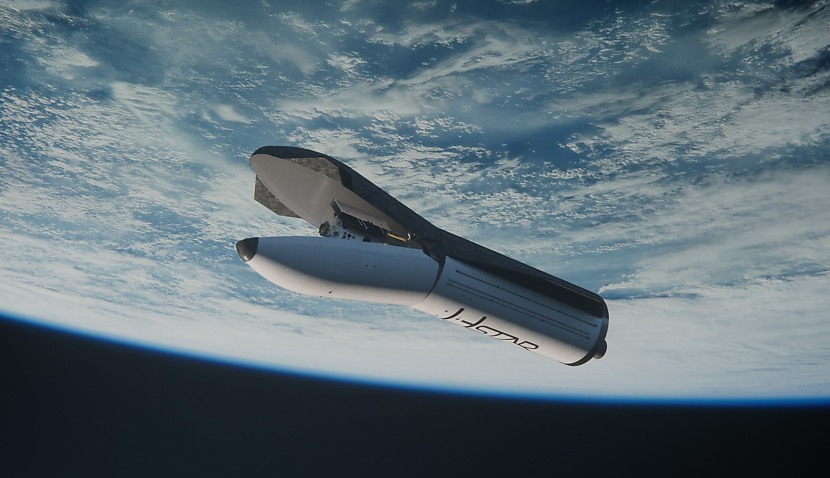
Space Connect: Tell us a little bit about what Hstar does?
Nick Orenstein: Hstar is a global collaboration for global space access. We’re a Franco-American company focused on cooperation, flexibility and longevity. Our French team is building a heavy-class rocket launcher, while our U.S. team is developing an orbital shuttle for in-space transportation. Together, we’re creating systems that can take satellites, cargo, and people to space.
We’re also working with countries around the world to ensure global participation – hence, the “H” in Hstar stands for “Humanity.” One of our most exciting partnerships is with Space Centre Australia, a new launch site in Queensland. It’s ideally located near the equator and provides an incredible opportunity for launching satellites and building a space ecosystem that Australians can be proud of. We’re also non-dependent, which, for us, is a broader way to describe sovereign launch. Governments don’t want to be dependent on other countries for launch, and commercial customers don’t want to depend on a single rocket company as a monopoly to get to space. We provide flexibility because we’re not a government – we’re a commercial company acting as a kind of “rocket diplomat,” helping countries and companies bridge gaps and access space on their terms.
SC: Talk us through these rockets – they’re huge.
NO: We’re creating what’s called a heavy-class rocket – think of it like a jumbo jet for space. Just like aviation has small propeller planes, business jets, and jumbo jets, rocketry has similar scales. Many companies are building rockets that can carry about a ton to orbit – those are your “propeller planes.” Others, like Falcon 9 or Ariane 6, can take around 20 tons – more like business jets. Our launcher is designed to carry up to 60 tons – large satellites, space station modules, even people. That capacity opens the door to transformative infrastructure in Earth orbit.
SC: Designing those must be incredibly difficult. How did you start?
NO: We came together as a team in 2022. Many of us worked at places such as SpaceX, NASA and Thales Alenia. We’ve since developed the system architecture, confirmed the maths and science are accurate, and built a business plan. This year is when we begin building. We’re tackling it in phases –first focusing on enabling technologies that not only help us but could also be licensed or sold to other companies. We’re acting as a systems integrator, working with subcontractors across Europe – and hopefully in Australia too. There’s now a global supply chain for rockets that didn’t exist just a few years ago, which helps us move faster and more cost-effectively.
SC: What drew you to work with Space Centre Australia?
NO: There were several reasons. One was serendipity, of course, of meeting that team. I had already met with other Australian launch locations, but I immediately felt a camaraderie with SCA over the global vision of what we were each doing as companies. Their site in Queensland is close to the equator – ideal for launch – and it’s cleverly situated on land, which avoids environmental issues like launching immediately over the Great Barrier Reef. Australia is also a natural partner for us with strong ties to the U.S. and UK, and a growing focus on expanding Australia’s space capabilities – we want to be a part of those government and commercial agreements and trade associations.
SC: Who are your potential customers?
NO: We see three main markets: satellites, cargo, and passengers. Within satellites, there’s a huge need to launch constellations – hundreds of satellites at once. Our heavy-class rocket can carry more of them in fewer launches, saving time and money. We’re also looking at infrastructure – fuel depots, space station modules, and orbital assembly. And once those are operational, we can resupply them with cargo and eventually crew. We’re a transportation company focused on building the infrastructure of space in Earth orbit.
SC: A lot of companies are targeting smaller launches. What makes you different?
NO: Heavy-class rockets are rare. There are a number of other small and medium launchers, but right now, the only other heavy launch player is Starship from SpaceX. One of our selling points is the ability to launch from multiple places in the world including and especially Australia. Another is our focus on Earth Orbit infrastructure. While others are focused on the Moon or Mars, we’re focused on Earth orbit. We’re about space for Earth – things that improve life down here.
SC: How did you personally get involved in Hstar?
NO: It started with a former mentor from SpaceX who introduced me to one of Hstar’s co-founders. It was like forming a band with people you’ve jammed with before! I’d spent six and a half years at SpaceX working on Crew Dragon and loved it. But my dream started much earlier. When I was five, I told my teacher I wanted to be an astronaut. I spent years doing engineering in other fields before realizing I had to go for it. So I went back to grad school, focused on astronautics, worked closely with great NASA astronauts, and helped engineer the first all-civilian orbital mission. I’m living my childhood dream even if I haven’t gone to space yet, as so are many others in the space industry.
SC: Are you also recruiting or looking for partners?
NO: Absolutely. This is a year of Australia for us with multiple visits. We’re recruiting world-class people and subcontractors to help develop and build our spaceport location in Queensland. And we’re looking for launch customers who want to be the first Australians to launch heavy payloads from Australia.
Receive the latest developments and updates on Australia’s space industry direct to your inbox. Subscribe today to Space Connect here.












